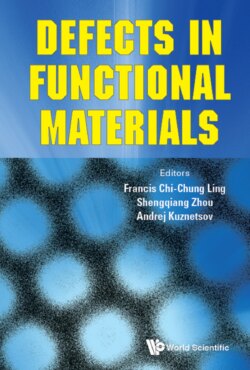Читать книгу Defects in Functional Materials - Группа авторов - Страница 24
3.1.3. Local magnetism induced by antisite defects
ОглавлениеIn the nonmagnetic MoS2, sulfur vacancies VS, VS2 will not induce any local magnetism [19] to the monolayer or multilayer. Through advanced first-principles calculation, Jin et al. found that only antisite MoS will give rise to local magnetism in monolayer MoS2, while antisite MoS2 is nonmagnetic. The calculated electronic structures of the most common antisites MoS and MoS2 are shown in Fig. 4. The defect states behave as nearly flat band dispersion within the intrinsic bandgap, indicating the excessive involvement of Mo d electrons (four Mo atoms within the ansite defect). Further, the density distribution of the extended electron wave function around the antisite forms a “superatom” with a radius of roughly 6 Å, representing the hybridization of Mo d and S p orbitals (Figs. 4(e) and 4(f)).
Figure 3. Atomically resolved ADF-STEM images to reveal the distribution of different point defects. (a) Antisite defects in PVD MoS2 monolayers. Scale bar: 1 nm. (b) Vacancies including VS and VS2 observed in ME monolayers, similar to those observed for the CVD sample. Scale bar: 1 nm. (c) and (d) Histograms of various point defects in PVD, CVD, and ME monolayers. ME samples are in green, PVD samples in red, and CVD in blue. Reproduced from Jin et al. (2015) with permission.
Figure 4. Electronic properties of the predominant antisite defects in the MoS2 monolayer. (a) Band structure and the corresponding density of states (DOS) of the antisite defect MoS2. The gray bands are from normal lattice sites, similar to the conduction band and valence band of a perfect monolayer, while the discrete red bands show the localized defects states. The DOS is projected onto the atoms around the defect (defect) and those in the middle plane of two adjacent defects (pure), respectively. The gray dash line indicates the position of the Fermi level. (b) and (c) Real-space distribution of the wave functions of the two defect states below and above the Fermi energy. (d) The band structure and DOS of antisite MoS, with a color scheme similar to that in (a) but the two spin components are colored in red (spin-up) and blue (spin-down), respectively. (e) Spin density of antisite MoS, as defined ρup − ρdown, charge densities ρup and ρdown are spin-resolved for spin-up and down components, which are represented by yellow and blue isosurfaces, respectively. (f) Spin-resolved real-space distribution of the wave function of the two marked defect states (state 3) in (d). The isosurface value in (b), (c), (e) and (f) is 0.001e · Bhor−3. Reproduced from Jin et al. (2015) with permission.
Antisite MoS2 is calculated to be nonmagnetic, as shown in Fig. 4(a). The calculated spin-polarized charge density of antisite MoS in Fig. 4(e) presents the magnetic structure with a total magnetic moment of 2µB. Figure 4(f) plots the spin-resolved distribution of a defect-induced state (state 3) marked in Fig. 4(d) to illustrate the origin of the magnetism. The occupied spin-up component (yellow isosurface) is mainly composed of dxy and dx2−y2 orbitals of the antisite Mo atom, while the unoccupied spin-down component (cyan isosurface) is projected onto dxy and dz2 orbitals of the surrounding Mo atoms, consistent with the total spin charge density shown in Fig.4(e).
The difference of magnetic MoS and nonmagnetic MoS2 can be well explained by crystal field theory and hybrid orbital theory. For three-fold symmetric MoS, the antisite Mo takes d4s hybridization with five orbitals, i.e.,s, dxz, dyz, dxy, and dx2−y2. The former three orbitals are filled by six electrons from the antisite Mo and the latter two orbitals are filled by two electrons from the adjacent Mo atoms. Hence, these two degenerate orbitals accommodate unpaired electrons whose spin directions are parallel due to the on-site Coulomb repulsion according to Hund’s rules. Thus, these two unpaired electrons lead to the magnetic moment of 2 µB. For antisite MoS2, the offcenter characteristic in structure gives rise to the absence of orbital dxz in the formation of hybridization. Hence, the antisite Mo takes d3s hybridization forming four hybridized orbitals, originated from s, dxy, dx2−y2, dyz, filled by eight electrons. As a result of the d3s hybridization, antisite MoS2 is non-magnetic. The structural symmetry breaking of antisite MoS2 makes a big difference in the magnetic properties [19], in contrast with the antisite MoS.
